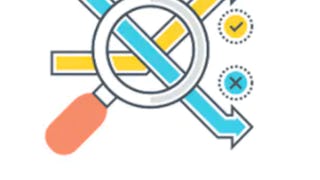Sequential Decisions baut auf Mathematik und Algorithmen auf, die von Coursera-Studenten verstanden und verwendet werden können. Dieser Kurs beginnt mit einer Betrachtung der einfachsten Art von Datenströmen und geht dann schrittweise zu komplexeren Datentypen und differenzierteren Entscheidungen über diese Daten über. Sie werden in der Lage sein: (a) optimale Entscheidungen für Daten zu programmieren, die aus bekannten Verteilungsfunktionen stammen, (b) Fehlerbalken und nuancierte Absicherungen über laufende Datenströme zu definieren, um fehlende Daten und/oder fehlendes Wissen zu reflektieren, (c) die Verbindungen von diesen Modellen zu verstehen und zu nutzen, um Markov-Ketten und Markov-Prozesse besser zu verstehen und wie diese Ideen mit Reinforcement Learning verbunden sind und (d) die Nuancen zwischen zeitunabhängigen, zeitabhängigen, ein- und mehrdimensionalen Daten besser zu verstehen.

Genießen Sie unbegrenztes Wachstum mit einem Jahr Coursera Plus für 199 $ (regulär 399 $). Jetzt sparen.

Datenwissenschaftliche Entscheidungen in der Zeit: Daten effektiv nutzen
Dieser Kurs ist Teil von Spezialisierung für Datenwissenschaftliche Entscheidungen in der Zeit

Dozent: Thomas Woolf
Bei enthalten
Empfohlene Erfahrung
Was Sie lernen werden
Am Ende des Kurses werden Sie: (1) verstehen, wie sequenzielle Tests ablaufen und wann man aufhören sollte, Daten zu sammeln, und (2) wie dieses Konzept heute angewendet wird.
Kompetenzen, die Sie erwerben
- Kategorie: Bayessche Statistik
- Kategorie: Schätzung
- Kategorie: Wahrscheinlichkeitsverteilung
- Kategorie: Zeitreihenanalyse und Vorhersage
- Kategorie: Statistische Methoden
- Kategorie: Statistische Analyse
- Kategorie: Reinforcement Learning
- Kategorie: Stichproben (Statistik)
- Kategorie: Vorhersage
- Kategorie: Datengesteuerte Entscheidungsfindung
- Kategorie: Markov-Modell
- Kategorie: Methoden des Maschinellen Lernens
- Kategorie: Anomalie-Erkennung
- Kategorie: Datenverarbeitung
Wichtige Details

Zu Ihrem LinkedIn-Profil hinzufügen
11 Aufgaben
Erfahren Sie, wie Mitarbeiter führender Unternehmen gefragte Kompetenzen erwerben.

Erweitern Sie Ihre Fachkenntnisse
- Lernen Sie neue Konzepte von Branchenexperten
- Gewinnen Sie ein Grundverständnis bestimmter Themen oder Tools
- Erwerben Sie berufsrelevante Kompetenzen durch praktische Projekte
- Erwerben Sie ein Berufszertifikat zur Vorlage

In diesem Kurs gibt es 5 Module
In diesem Modul werden die Klasse und der Lehransatz vorgestellt, der in den nächsten fünf Wochen verwendet werden soll. Wir beginnen mit einfachen sequentiellen Daten, ähnlich dem Wald'schen Modell: Die Daten kommen aus einer Verteilung und sind nicht zeitabhängig. Dies können generative Daten sein. Anschließend untersuchen wir zunehmend komplexere Daten aus Verteilungen, die aus gesundheitlichen oder geschäftlichen Gründen erhoben werden. Wir beenden die Woche mit Verbindungen zur Code-Arbeit und zur KI.
Das ist alles enthalten
5 Videos2 Lektüren2 Aufgaben1 Diskussionsthema
Dieses Modul ist die Bridge zu Markov-Prozessen und Markov-Ketten. Die Stichprobe von Thompson ist ein alter Algorithmus, der wiederbelebt wurde und derzeit bei vielen anspruchsvollen Problemen eingesetzt wird. Wenn die Studierenden dieses Material und die Verbindungen zur letzten Woche und zur kommenden Woche verstehen, werden sie gut positioniert sein, um diesen ersten Kurs in der Spezialisierung zu meistern
Das ist alles enthalten
3 Videos1 Lektüre2 Aufgaben1 Diskussionsthema
Änderungspunkte sind Orte, an denen sich die zuvor stationären Verteilungen der letzten beiden Module zu einer neuen Verteilung verschieben. In einer Fertigungsstraße könnte dies auf eine neue Charge von Materialien zurückzuführen sein, die mit anderen Eigenschaften ankommen, so dass sich die Ausfallrate ändert.
Das ist alles enthalten
2 Videos1 Lektüre2 Aufgaben1 Diskussionsthema
Markov-Ketten beschreiben eine Abfolge von Zustandsänderungen. Sie werden häufig zur Beschreibung komplexer Übergänge zwischen Zuständen verwendet und sind ein primäres Modellierungsinstrument zum besseren Verständnis eines komplexen Systems. Wir werden sie als Modell dafür verwenden, wie sequenzielle Daten von einem komplexeren System erzeugt werden können.
Das ist alles enthalten
3 Videos1 Lektüre2 Aufgaben1 Diskussionsthema
Der nächste Schritt in der Modellierungsfähigkeit sind Markov-Prozesse mit Entscheidungen. Dies knüpft an die moderne Forschung im Bereich des Bestärkenden Lernens an und ermöglicht die Optimierung der Entscheidungsmengen für ein optimales Ergebnis. In dieser letzten Woche des ersten Kurses werden wir die Grundlagen behandeln, wie diese Markov-Entscheidungsprozesse parametrisiert werden können und was sie bedeuten.
Das ist alles enthalten
2 Videos1 Lektüre3 Aufgaben1 Diskussionsthema
Erwerben Sie ein Karrierezertifikat.
Fügen Sie dieses Zeugnis Ihrem LinkedIn-Profil, Lebenslauf oder CV hinzu. Teilen Sie sie in Social Media und in Ihrer Leistungsbeurteilung.
Dozent

Mehr von Datenanalyse entdecken
 Status: Kostenloser Testzeitraum
Status: Kostenloser TestzeitraumJohns Hopkins University
 Status: Kostenloser Testzeitraum
Status: Kostenloser Testzeitraum Status: Kostenloser Testzeitraum
Status: Kostenloser TestzeitraumJohns Hopkins University
 Status: Kostenloser Testzeitraum
Status: Kostenloser TestzeitraumJohns Hopkins University
Warum entscheiden sich Menschen für Coursera für ihre Karriere?





Neue Karrieremöglichkeiten mit Coursera Plus
Unbegrenzter Zugang zu 10,000+ Weltklasse-Kursen, praktischen Projekten und berufsqualifizierenden Zertifikatsprogrammen - alles in Ihrem Abonnement enthalten
Bringen Sie Ihre Karriere mit einem Online-Abschluss voran.
Erwerben Sie einen Abschluss von erstklassigen Universitäten – 100 % online
Schließen Sie sich mehr als 3.400 Unternehmen in aller Welt an, die sich für Coursera for Business entschieden haben.
Schulen Sie Ihre Mitarbeiter*innen, um sich in der digitalen Wirtschaft zu behaupten.
Häufig gestellte Fragen
Um Zugang zu den Kursmaterialien und Aufgaben zu erhalten und um ein Zertifikat zu erwerben, müssen Sie die Zertifikatserfahrung erwerben, wenn Sie sich für einen Kurs anmelden. Sie können stattdessen eine kostenlose Testversion ausprobieren oder finanzielle Unterstützung beantragen. Der Kurs kann stattdessen die Option "Vollständiger Kurs, kein Zertifikat" anbieten. Mit dieser Option können Sie alle Kursmaterialien einsehen, die erforderlichen Bewertungen abgeben und eine Abschlussnote erhalten. Dies bedeutet auch, dass Sie kein Zertifikat erwerben können.
Wenn Sie sich für den Kurs einschreiben, erhalten Sie Zugang zu allen Kursen der Spezialisierung, und Sie erhalten ein Zertifikat, wenn Sie die Arbeit abgeschlossen haben. Ihr elektronisches Zertifikat wird Ihrer Seite "Leistungen" hinzugefügt - von dort aus können Sie Ihr Zertifikat ausdrucken oder Ihrem LinkedIn-Profil hinzufügen.
Ja. Für ausgewählte Lernprogramme können Sie eine finanzielle Unterstützung oder ein Stipendium beantragen, wenn Sie die Anmeldungsgebühr nicht aufbringen können. Wenn für das von Ihnen gewählte Lernprogramm eine finanzielle Unterstützung oder ein Stipendium verfügbar ist, finden Sie auf der Beschreibungsseite einen Link zur Beantragung.
Weitere Fragen
Finanzielle Unterstützung verfügbar,

